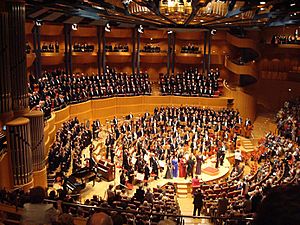Symphony facts for kids

A symphony is a special kind of music written for a large group of musicians called an orchestra. Symphonies are usually quite long. They are often split into several main parts, which are called movements. Most symphonies have three or four movements.
Contents
What Are the Parts of a Symphony?
Each movement in a symphony has its own feeling and speed.
- The first movement is often fast and exciting. It might use a structure called sonata form.
- The second movement is usually slow and calm.
- The third movement can be a minuet (a dance-like piece) or a scherzo (a playful, fast piece).
- The fourth movement is often called the "Finale." It can be fast and lively, sometimes using Rondo form or sonata form.
Many composers, like Joseph Haydn, used this pattern for their symphonies. Haydn is even known as the "Father of the Symphony" because he wrote so many and helped set this common structure.
Where Does the Word "Symphony" Come From?
The word "symphony" has Greek roots. It comes from two words:
- "Sym," which means "together."
- "Phone," which means "sound."
So, "symphony" means "sounding together," which makes sense for an orchestra!
You might also hear the word "symphonic." This describes music that sounds like a symphony. It usually means the music is long and develops its tunes over time.
What is a Symphony Orchestra?
A large group of musicians who play symphonies is often called a "symphony orchestra." This helps people tell the difference between a big orchestra and a smaller one, which is called a "chamber orchestra."
Famous Symphony Composers
Many great composers have written amazing symphonies. Some of the most famous include:
- Joseph Haydn
- Wolfgang Amadeus Mozart
- Ludwig van Beethoven
- Franz Schubert
- Felix Mendelssohn
- Robert Schumann
- Anton Bruckner
- Johannes Brahms
- Pyotr Tchaikovsky
- Gustav Mahler
- Jean Sibelius
- Dmitri Shostakovich
See also
 In Spanish: Sinfonía para niños
In Spanish: Sinfonía para niños

